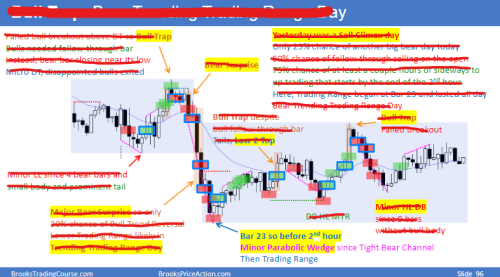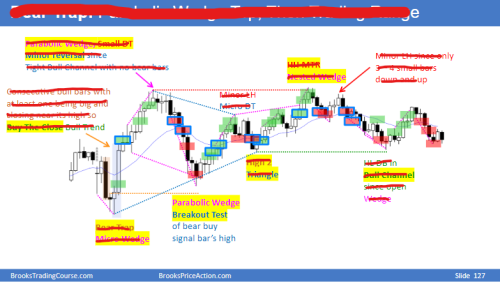The support forum is built with (1) General and FAQ forums for common trading queries received from aspiring and experienced traders, and (2) forums for course video topics. How to Trade Price Action and How to Trade Forex Price Action videos are consolidated into common forums.
Brooks Trading Course social media communities
Hello,
I am struggling to understand what Al means when he says a pattern is minor. For example, he often says a wedge is minor. As far as I understand, a minor trend reversal in a trend or strong breakout is generally going to result in trend resumption or a trading range 70 percent of the time and a major trend reversal 30 percent of the time (the minor reversal becomes major 30 percent of the time). Traders assume any attempt at trend reversal is minor untill one is surprisingly strong, and then the next one has 40 percent probability of being a major trend reversal.
Since the below example of a parabolic wedge bottom on slide 96 is marked as minor, I believe this means the market is probably going to resume the bear breakout creating a 2nd leg down or transition into a trading range. The unlikely scenario is a major reversal into a bull trend.
If the parabolic wedge bottom is not marked as minor, as seen on slide 127, does this imply it is a major pattern with 40 percent probability of it being a major reversal (I really don't think this is true), or does it simply imply there is sligthly decreased probability of trend resumption and slightly increased probability of a trading range or major reversal. Perhaps there is a 3rd explanation on how to differ between the minor parabolic wedge and the "regular" (or major?) parabolic wedge?
Slide 96 in Daily Setups Volume 11
Slide 127 in Daily Setups Volume 11
Help is appreciated,
Andreas
Hi Andreas,
The first slide has a bit of a giveaway since it says right there "minor wedge since tight bear channel". When there's a tight channel/leg or even a whole day that's a small pullback trend, Al often says, for example, "bulls broke out, but the first time one side does anything it's probably minor."
The second slide is trickier since the bear leg also looks tight. Maybe a clue is in the fact that this leg accomplished something i.e. tested the breakout point. Once one side accomplishes some target there's often a deeper PB/more extensive sideways range rather than resumption of trend.
Also notice how strong the bear bars are in the first slide all the way to the bottom, while in the 2nd slide they start getting tails and smaller bodies.
So signs of strength of bars, tightness, and goals/targets reached are some things to look for when considering if a PB/reversal attempt is going to be minor or major.
Hope that helped!
CH
____________________________
BPA Telegram Group
Hello Mr. Carpet,
Thank you for the reply.
What I don't understand is, the specific difference between how a pattern that is marked as minor, and a pattern that is not marked as minor behaves?
And when a pattern is not marked as minor, does that imply it is major, so in reality there are only minor and major patterns?
Andreas
A minor reversal is more likely to end up as TR while a major reversal (e.g. MTR) is taken in hopes of the market reversing into an opposite trend.
This is a very important concept. Please review the two slides side by side as context is completely different.
Important aspects, as already mentioned are tightness of the channel, and often wedges have implications to them depending on context.
Example, Al will often say after 3 pushes (wedge formation) look for a reversal. However this is context related. If the wedge is formed as a channel, there are retracements to previous target, and overlap. Signs of weaking, and weaking in channel formations have a higher probability of reversal.
However, in this specific case, both examples are wedges formed from a spike potential situation. The pullbacks are minor and there are potentially trapped bulls in both situations.
This is the most important part though. In the first case, there is a trending environment and the tight wedge is not testing a known target from today. This is a trending environment, which means there are implications of what happens on the retracement and the test of the ema. The directional bias has been established. You will note that the long entry green box is after a good 2nd bull bar which has had a 2nd attempt to push lower first.
The 2nd situation though. Completely different! Consider big up, big down, potential trading range environment on a higher timeframe. The 3 pushes are "checking" the seriousness of the bulls 1st buy earlier in the day, as well as the 50% retracement of the strong bull bar that follows.
Very different. In the 1st case, potentially TBTL, and the long is a scalp. Note the differences in the 2nd situation with a better understanding of the context [big up - big down -> big indecision - Trading Range [Al Definition]
Good Trades To You!


